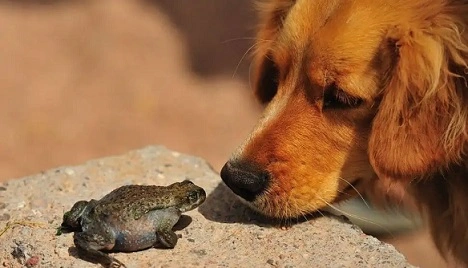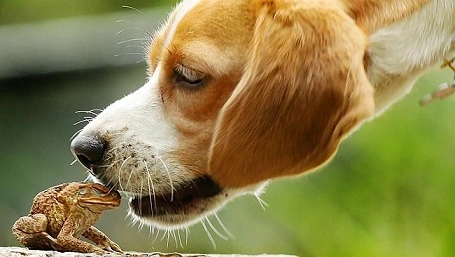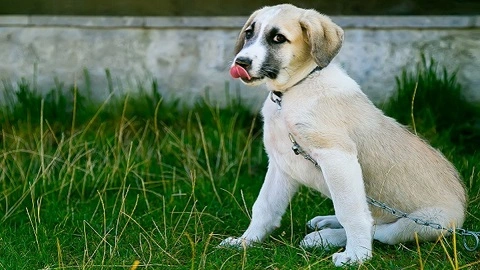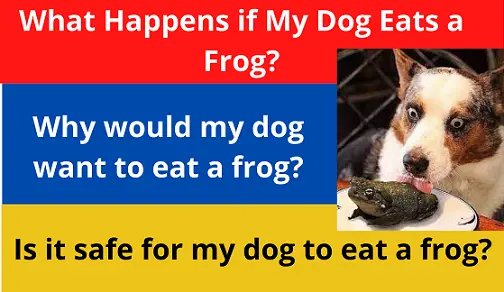What Happens if My Dog Eats a Frog? if you are looking for this query then you have reached the right place.
What should you do if you find out “my dog ate a frog”?
Some dogs are especially adventurous when it comes to food choices.
So almost all dogs are capable of giving us a heart attack when we realize how disgusting that thing they just ate was.
What if your dog ate a frog? Aside from the grizzly nature of the find, your head is probably in a spin on what to do next.
Are frogs dangerous ?, Should I take my dog to the vet? Will my little dog die ?!
The situation can be troubling, to say the least.
Let’s break it down, so the next time your dog presents evidence that they just ate a frog you know exactly what to do.
Is it safe for my dog to eat a frog?
The answer to this question largely depends on the type of frog your dog ate.
There are many different types of frogs out there.
Some aren’t technically frogs, but rather toads.

Different species of frogs and toads inhabit different parts of the world., Some are highly toxic, others are harmless.
To list which species are toxic and which are not would result in a very long article filled with lists and descriptions that would take too long to read in an emergency situation.
So in this article, we will discuss some basics that will come in handy whenever you find that your dog has eaten a frog, whether it’s poisonous or not.
While it may sound gross, if your dog came to you with the frog hanging out of his mouth, put it in a bag or bottle to show the vet.
This way your dog’s vet can determine what kind of frog your dog ate.
My dog ate a frog – When should you call the vet
If your dog begins to show signs of illness, giving first aid immediately and seeking medical help is more important than collecting a “sample” of their amphibious victim.
Even if you’re sure the frog isn’t poisonous, it’s a good idea to get in touch with your vet to describe the symptoms.

Your vet can help you decide on the best course of treatment, even if you don’t need to take your dog to the clinic.
Frogs can also carry parasites that could infect your dog. Therefore, it is good for your vet to know that your dog has eaten a frog.
This can be important when diagnosing any future infections that may arise.
If you are interested, it is recommended that you familiarize yourself with the types of frogs and toads that inhabit your area.
This way you can give the vet a lot of information., You will also be more prepared for an emergency if you know a particularly toxic type of frog or toad living near you.
My dog ate a frog – What should I do?
If your dog brings you what’s left of the frog as a gift, try taking it out of his mouth.
Also, try to stay calm so that removing the frog or toad from your dog’s mouth doesn’t become another problem of its own!
So, wash your dog’s mouth.,
This does not mean squirting water into your dog’s throat, which could choke your dog or spread toxins further down their digestive tract,
Instead, moisten a washcloth and wipe the inside of your dog’s mouth and gums.
Rinse the cloth thoroughly between each wipe and continue doing this for about 10 minutes.
If the frog is poisonous, this may help remove some of the toxins before they are absorbed into your dog’s system.
Often, the toxins excreted by frogs and toads are quite sticky, so sweeping out your dog’s mouth can be very effective in reducing the effect of poisoning.
So if you can, collect a sample of the offending frog and take your dog to the vet.
Give your vet as much information about your dog as possible. Make a note of any symptoms and the order in which they appeared.
Let your vet know about any pre-existing conditions your dog has and any medications they are on as well.
What are the side effects of a dog eating a frog?
Your dog may be foaming at the mouth. This is quite common if a dog has ingested or even just licked a frog or toad.
Foam is a natural cleansing mechanism to help get rid of toxins.
Your dog isn’t necessarily about to die, but administering first aid quickly is still vital. This will reduce the chances of severe poisoning or death.
Symptoms vary based on the exact toxin produced by a particular frog or toad, as well as the amount ingested by the dog.
Other symptoms can include
- looking stunned
- bright red gums
- agitation
- convulsions
- abnormal heart rhythm
- respiratory difficulties
- collapse.
If you are unsure how serious the situation is, call your dog’s vet and describe the symptoms.
They can advise you on first aid treatments, additional symptoms to look for, and what you should do next.
Why would my dog want to eat a frog?
We know that dogs are inherently curious. Hence, the noises and movements of a frog can be quite irresistible to them.
Most dogs probably don’t eat frogs out of hunger, they are more likely to have ended up ingesting the toxins by licking or mouthing the frog in an attempt to play.
Many types of frogs and toads burrow and live under the shelter of leaves.
Considering dogs love to dig, the likelihood that your dog will run into a frog or toad when they are going on their backyard adventures is high.
How to stop your dog from eating frogs?
Aside from locking your dog all day, there is little you can do to ensure your dog never comes in contact with a frog.

Especially if you live in an area where frogs and toads are common.
If you live in an area with lots of frogs and toads, find out where they tend to dig and what time of day they are most active.
It may be a good idea to restrict your dog’s access to these areas during times frogs and toads are likely to be hopping on their business.
For example, in Australia, a cane toad commonly causes dogs pain.
But most poisonings happen in the evening when the toads are most active and the dogs play in the yard.
My dog ate a dead frog. What do I do?
While it may help to know which frog and toad species live in your area, it is not necessary to become an expert on the subject to treat your dog if they have eaten a frog.
Remember that not all frogs are poisonous, but some are highly toxic or can carry parasites that could infect your dog.
For these reasons, it’s a good idea to know some basic first aid.
It’s also a good idea to at least call your vet for advice, even if you think the frog is harmless.
If your dog seems unwell, the best course of action is to get your dog to the vet as soon as possible.
Unfortunately, frogs and toads are very attractive to dogs – anything jumping so seems like a lot of fun for a dog, especially if they found the offender while digging !,
Stopping your dog from eating them can be a challenge, but having an action plan in place in case they do is definitely a must, particularly if your dog has a thing for frogs.
Has your dog ever eaten a frog? We’d love to hear your experience in the comments below.
How do I know if my dog has eaten a frog?
Symptoms that a frog was poisonous to your dog. You may notice these symptoms if your dog has eaten a poisonous frog: foam in the mouth. Stunned look. Bright red gums.
My dog ate a frog and is vomiting?
If have noticed that your dog has eaten a frog then wash out your dog‘s mouth with water and call your vet urgently. Make sure you don’t let that frog get away from your eyes because Proper identification of that frog breed can be an easy way to treat your dog.
Can frogs kill dogs?
Yes, frogs can kill your pets if they eat because they ooze a toxic substance from their skin or just around the frogs’ eyes. … Frogs are good for many things, but don’t spray chemicals on them as it’s a long and painful death for them and the chemicals will NOT kill them immediately!
Will eating a frog make a dog sick?
Dogs can die from eating frogs if it is a poisonous frogs. With non-toxic frogs, there are still health risks such as parasites causing infections or diseases such as salmonella.
At best, if your dog eats a frog, he may experience only mild irritation around his gums and mouth area. in this case, you should immediately take your dog to the vet.
My dog ate a dead frog. What do I do?
Most toads and frogs secrete a substance through their skin that tastes incredibly unpleasant (which could cause the dog to foam or leave a bad taste in the mouth) or is highly toxic. These highly toxic chemicals will quickly be absorbed through the dog’s mouth, nose, and eyes.
What do you do if your dog catches a frog?
The most effective treatment for acute toad toxicity is a thorough washing of the mouth with running water. Owners should do this immediately and before seeking veterinary care. It is important to point the dog’s head down so that the water is not swallowed.
My dog ate a frog and has diarrhea?
frog called bufo also known as the giant or cane frog is very dangerous. This frog releases bufotoxins in its parotid gland, which may create health issues and destroy your dog’s health system like shaking, vomiting, diarrhea, seizures, and heart arrhythmias.
If you see these symptoms then Immediate call your vet because this might be a critical situation for your dog, and your dog may die.
What are the side effects of a dog eating a frog?
If your dog has eaten a frog you will probably notice these symptoms which are given below
- looking stunned
- bright red gums
- agitation
- convulsions
- abnormal heart rhythm
- respiratory difficulties
- collapse.
How long does it take for a dog to get sick after eating a frog?
Your pet should be back to normal within 12-24 hours. The prognosis for consuming one of the poisonous toads is much more severe, especially if your pet has an underlying medical condition.
Can a dog digest a frog?
The first signs will be similar to slightly toxic toads: drooling, pawing, vomiting. But they will often progress to shock and neurological signs within 30 minutes to several hours, resulting in death.
Can a dog die from licking a frog?
To compensate for their slow escape, many toads are toxic. This means that if your pup eats, licks, or chews on a toad, he is potentially at risk for toad poisoning. While some toads simply taste bad, others are potentially lethal to your pup.
Why does my dog’s mouth foam after licking a frog?
What happens if a dog licks a toad? If your dog has licked, chewed, or eaten a cane toad, otherwise known as mouthing, the toxin is quickly absorbed through the gums. The toxin usually causes localized irritation to the gums, resulting in increased salivation/smearing which can be seen as foam from the mouth.
READ THIS ALSO:-
Conclusion –
Friends, I hope You must have liked the blog “What Happens if My Dog Eats a Frog?”
If you have any feedback, then definitely tell us by going to Contact Us, you can email me or follow me on social media Will see you soon with a new blog, till then stay tuned to my blog “Thanks



